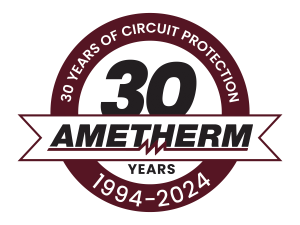Special Thermistors Limit Inrush Current
Mehdi Samii, Ametherm Inc., Carson City, Nevada
From PCIM (Power Electronics Technology) October 1998
Closing the Loop – pg 94
High inrush current can be produced when equipment is turned on. If steps are not taken to minimize this inrush current, it can damage power devices and reduce equipment life. A safe and cost-effective way to reduce inrush current is to use an inrush current limiter (Surge Limiter), which is a special type of negative temperature coefficient (NTC) thermistor.
Constructed with high temperature materials for long life and durability, an NTC thermistor’s resistance drops logarithmically as its body temperature increases. The function of a Surge Limiter is to first block the inrush current and then remove itself from the circuit. It blocks the incoming current spike by offering a relatively high resistance at turn on.
Typical resistance ranges are from 0.25 ohm to 220 ohm, depending on the amount of protection desired. As current flows through to the Surge Limiter, the resistance drops in milliseconds to as low as 0.01 ohm, which functionally removes it from the circuit.
Even though a fixed resistor can be used instead of an inrush current limiter there are advantages to using a Surge Limiter. A Surge Limiter typically occupies half the space as a similarly rated fixed resistor, provides a higher level of inrush current limiting, and its resistance drops to a negligible level.
The most important considerations when selecting a Surge Limiter for a particular application are the amount of inrush current limiting desired, its steady state current, and the amount of energy it will absorb. The Surge Limiter resistance determines to what extent the inrush current will be dampened.
In a switching power supply the Surge Limiter provides nearly all the resistance at turn-on because the large filter capacitors act as a short circuit. With a 120 Vrms input, the potential peak voltage is 170V. To limit peak current to less than 20A, use Ohm’s Law to find the Surge Limiter’s desired turn-on resistance:
Vpeak/Ipeak= Rmin
170V/120A = 8.5 ohm. Most Surge Limiters are specified with 15% to 20% tolerances. In this case a 10 ohm Surge Limiter would be a good selection. A Surge Limiter must be chosen that is rated for at least the same steady state current as the circuit being designed. While the peak current may be very high at turn-on, the steady state current will be somewhat lower.
To select the best Surge Limiter for an application, choose the smallest one available that is rated for the correct current. There is no need to derate the Surge Limiter because most manufacturers already derate the steady state current specifications. The benefits of selecting the smallest Surge Limiter possible are that less space will be required, less heat will be generated, the on resistance will be lower, and cost will generally be lower.
As noted above, the large filter capacitors appear as a short circuit at turn-on. Soon after, the capacitors develop a charge of ? CV^2, where C is the circuit capacitance and V is the peak voltage. This charge is the amount of energy that must be withstood by the inrush current limiter, ex-pressed in Joules.
Size and quality of construction generally determine the amount of energy that can be absorbed by a Surge Limiter. Therefore, care must be taken to select a Surge Limiter with sufficient ability to absorb energy. Failure to do so may result in catastrophic failure of the Surge Limiter.
The inrush current limiter is normally placed in series with the diode bridge, motor, or other components of a system that benefit from inrush protection. For added protection, two Surge Limiters can be placed in series.




